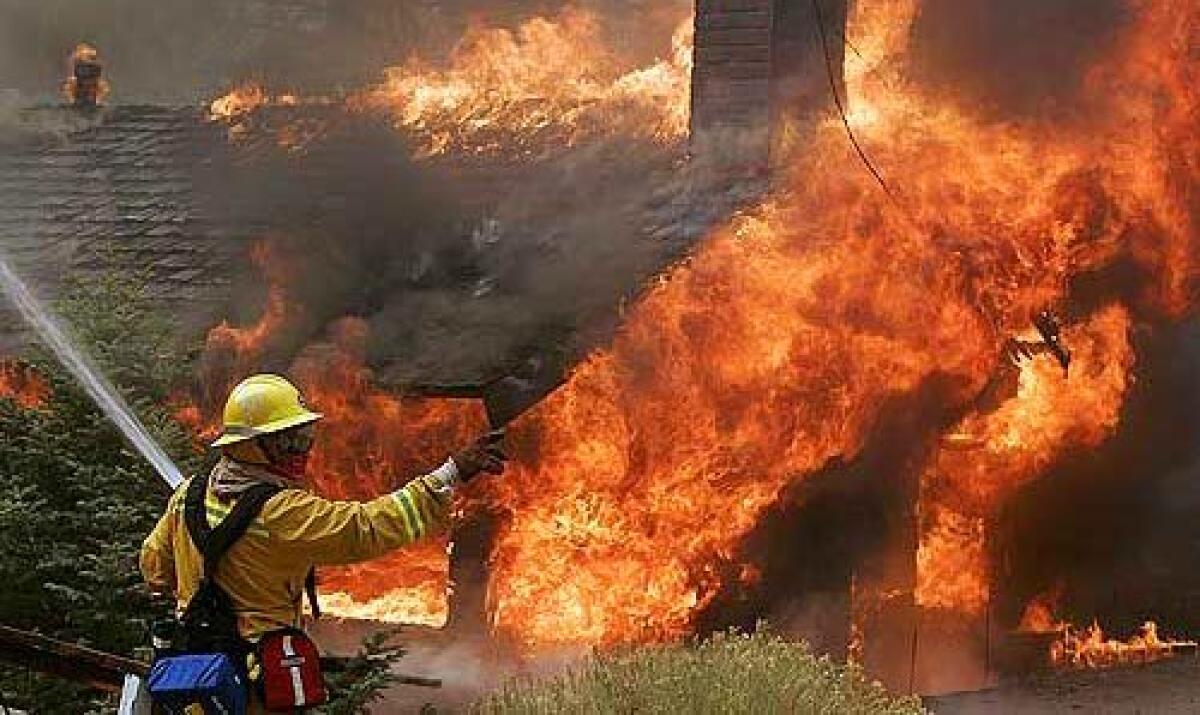Massive evacuations ordered as onslaught of fires spreads

For the latest fire updates, check our breaking news blog.
Wind-whipped firestorms destroyed more than 700 homes and businesses in Southern California on Monday, the second day of its onslaught, and more than half a million people in San Diego County were told to evacuate their homes.
The gale-force winds turned hillside canyons into giant blowtorches from Santa Barbara to the Mexican border. Although the worst damage was around San Diego and Lake Arrowhead, dangerous fires also threatened Malibu, parts of Orange and Ventura counties, and the Agua Dulce area near Santa Clarita.
Late Monday night, new blazes were menacing homes near Stevenson Ranch and in Soledad Canyon in northern Los Angeles County. The Soledad Canyon fire burned multiple mobile homes and evacuations were underway, fire officials said.
Gov. Arnold Schwarzenegger, calling it “a tragic time for California,” declared a state of emergency in seven counties and redeployed California National Guard members from the border to support firefighters. Schwarzenegger stressed how much California officials have learned since the devastating wildfires of October 2003, which raged over much of the same terrain.
But as the day wore on, it became clear that any hard-earned knowledge was no match for natural forces overrunning the ability of firefighters to control them.
“The issue this time is not preparedness,” said San Diego City Council President Scott Peters. “It’s that the event is so overwhelming.”
Pat Helsing, 59, evacuated her home in the Scripps Ranch area, much as she had done four years ago.
“It seems scarier this time,” she said. “The fire is everywhere in San Diego now. You don’t know where you can go to escape it.”
By late Monday, Southern California fires had burned 269,000 acres -- about 420 square miles -- and destroyed at least 892 buildings. Remarkably, only one person was known to have died, although it was possible that more fatalities would be discovered. At least 37 people had been injured, including 17 firefighters.
Near Malibu, where fire Sunday had burned into the center of town, the focus Monday was in the hills, where firefighters on the ground and in the air were trying to prevent flames from marching across Las Flores Canyon and into Topanga Canyon.
“It’s trying to move toward Topanga Canyon, parallel to the coastline,” said Manhattan Beach Battalion Chief Frank Chiella, near the Rambla Pacifico area. Firefighters were attempting to stay ahead of the fire and funnel it toward the ocean.
“If you let it get wide, that’s a lot more homes it could take out,” Chiella said. “We’re doing what we can to keep it from getting bigger; we’ve only lost one home today.”
Two fires on opposite sides of Lake Arrowhead had burned about 2,000 acres by Monday evening, destroying 138 buildings and prompting the evacuation of hundreds of residents from mountain resort communities.
In northern Los Angeles County, the Buckweed fire had swept through 35,000 acres by Monday evening, destroying 20 homes and two bridges, and causing the evacuation of about 15,000 people. It was burning toward Magic Mountain, but was partially contained.
In Orange County, where a suspected arson fire stretched the resources of local crews, residents along Calle Cabrillo in Foothill Ranch were packing cars and preparing to evacuate.
“We’ve been through this before,” Karen Royer said. “I believe in God, and I know everything will be good.”
Minutes later, a plume of dark smoke lifted over a ridgeline.
“Can I revise that?” she said. “Now I’m scared.”
The Orange County blaze, called the Santiago fire, was leaping relentlessly in a southeasterly direction, burning ominously close to the Foothill Ranch and Portola Hill communities. About 500 firefighters and two water-carrying helicopters stood between the fire and hundreds of homes, Battalion Chief Kris Concepcion said.
Several firefighters escaped major injuries when they deployed fire-retardant survival tents as they were overtaken by flames along Santiago Canyon Road.
As was the case in 2003, the most devastating fires were in San Diego County where, in some areas, stretched-thin firefighters were forced to seemingly write off entire swaths of habitation. Along Highway 78 east of Escondido, near the San Diego Wild Animal Park, homes burned unchecked on both sides of the highway and the only firefighters in sight were heading out. There were no aerial drops of fire retardant; no planes or helicopters were in the sky.
San Diego Fire Rescue Battalion Chief John Tomson worried that if the wind did not die down, fires could burn all the way through San Diego to the Pacific Ocean -- a cataclysm of almost unimaginable dimensions.
“We’re not going to stop it,” he said. “I don’t have any idea even where it is any more. I’m not sure anybody knows where it is anymore.”
Late Monday night, fire officials were trying to stop the fast-moving Witch fire from racing west down the San Dieguito River Valley to the ocean.
Some of the priciest communities in San Diego County lay in the path of the fire: Fairbanks Ranch, Rancho Santa Fe, Del Mar and Solana Beach, with gated communities, golf courses and a polo field. From the fire’s origin near Ramona, it is 35 miles to the ocean.
“It’s already halfway there,” said San Diego Fire Department spokesman Maurice Luque.
San Diego County Sheriff Bill Kolender said in a radio interview that he expected the fires to be worse than the Cedar fire of 2003, the worst in California history. That, however, would mean a great deal more devastation than had occurred by late Monday. The Cedar fire burned 270,000 acres, destroyed more than 5,000 buildings and killed 15 people.
Some offered glimmers of optimism.
“Today was a day of twists and turns, but twists and turns for the better,” said Chief Ray Chaney, air tactical group supervisor with the state fire agency.
Speaking from the Ramona Airport, where a command center was located, he said: “There are certainly areas where we’re having difficulty getting air crews and ground crews to the fire.”
But, he said, in the Deer Horn Valley, just north of the Mexican border, “we were able to make a stand and succeeded.” He said a DC-10 water tanker was able to tamp down the fire to the point where “it went from black boiling flame to a white smoke.”
Still, in Poway, a city of about 50,000 northeast of San Diego, an enormous fork of the Witch fire exploded at dusk and began racing across hillsides peppered with million-dollar homes.
Seventy structures, almost all of them homes, had been lost by 7:30 p.m., said City Atty. Lisa Foster. About 7,000 households were under a mandatory evacuation order, and about two-thirds of the town’s population had left. No injuries to firefighters or civilians were reported.
But even with emergency aid pouring into the region, only 80 firefighters were in Poway -- about one for every structure that had been lost. At one point Monday afternoon there were three separate fires in Poway, each destroying structures, said Fire Division Chief Kevin Kitch.
“The entire area is just starved for resources,” Kitch said. “This is just too big.”
Firefighters were hoping that the winds might drop enough to permit large-scale air drops of water or flame retardant.
“It’s all dependent on the weather,” Kitch said. “This is a very, very intense fire, with shifting winds, driving winds, no moisture, no humidity -- in a drought-stricken area.”
The weather conditions prompted an ominous forecast from the National Weather Service, which called for a continuation of “strong, hot, dry, damaging Santa Ana winds.” The winds were expected to diminish only slightly today, but further Wednesday, offering the hope of gradually improving conditions for firefighters.
Santa Anas sweep in off the desert, blow-drying vegetation and providing a perfect bellows for wildfires.
The sheer ferocity and sweep of the firestorm, and the scale of its impact, created surreal images throughout the region.
In the Rancho Bernardo area in north San Diego County, more than 1,500 people, 2,200 horses and other animals, including chickens, a zebra and a zorse (a cross between a zebra and a horse), took refuge at the Del Mar fairground and racetrack.
At least 5,000 people were evacuated to Qualcomm Stadium, home of the San Diego Chargers, inviting comparisons to Hurricane Katrina evacuees who were housed in squalor at the Louisiana Superdome. The scene at Qualcomm, though, could hardly have been in sharper contrast.
Massage therapists gave massages. A clown gave funny-shaped balloons to children. A musician serenaded evacuees on jazz guitar. The scene in the parking lot was closer to a tailgate party than a disaster evacuation -- until children appeared in surgical masks to keep out the soot and ash.
Lee and Evelyn Morgan, married 61 years, evacuated from Rancho Bernardo before sunrise. They spent the day in the part of the stadium reserved for older people and the medically needy.
“It’s almost like a picnic,” said Lee, a retired engineer, as he pointed to the food spread. “Then you remember why you’re here, and it’s not a picnic at all.”
At least 233,000 households in San Diego County were asked to evacuate. At 2.7 people per household, which is the county average, that would amount to about 620,000 people. Although all did not necessarily heed the request to leave their homes, enough did to tax evacuation centers and cause massive traffic jams on freeways.
Like a scene out of the movie “War of the Worlds,” traffic northbound on Interstate 5 from Oceanside to San Juan Capistrano was bumper to bumper, cars and trucks loaded with belongings as people headed to relative safety to the north, black smoke darkening the sky behind them.
Schwarzenegger spoke to President Bush twice about the fires, his office said. The first call was initiated by Bush, who asked if there was anything the federal government could do to help. Later, Schwarzenegger called Bush to ask if the military at Camp Pendleton could make resources such as cots, blankets and water available to evacuees. The White House did not immediately respond.
Throughout the region, people were forced to make difficult decisions -- whether to evacuate or, if they had to leave, what to take.
As flames slowly made their way toward Stevenson Ranch late Monday afternoon, Ava Raich was packing valuables when a sheriff’s deputy warned residents of a mandatory evacuation. Raich, who has five children, including twins, a boy and a girl in the first grade, said she packed computers, important family papers and photographs.
“I packed each of the younger kids’ special blankets,” she said. “I also packed my grandfather’s WW II Marine uniform and his purple heart. It’s that kind of stuff you can’t replace.”
In Escondido, about 70 cars were stopped on an overpass of Interstate 15 as people watched their million-dollar homes burn. The cars were crammed with possessions and animals.
Cindi Stetson, 44, lives in the Montclair neighborhood of Escondido. She was stopped with her children, Kelly, 10, and Jackson, 6, in the back seat of their car, along with the family cat, Max. Stetson was an old hand at the fire evacuation scene.
“You have to keep a balance between fear and calm,” she said. “We had the same fear four years ago, and we packed better this time.”
As she spoke, her cellphone rang. It was her husband, Bill, a San Diego police officer.
“Honey,” he said, “I think our house is going.”
mitchell.landsberg@ latimes.com
More to Read
Sign up for Essential California
The most important California stories and recommendations in your inbox every morning.
You may occasionally receive promotional content from the Los Angeles Times.











